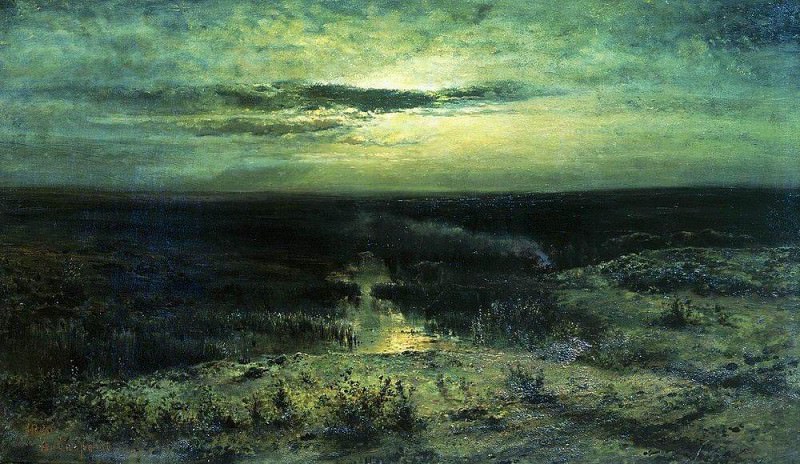Moonlit Night. Swamp. 1870 Alexey Kondratievich Savrasov (1830-1897)
Alexey Kondratievich Savrasov – Moonlit Night. Swamp. 1870
Edit attribution
Download full size: 1000×580 px (0,2 Mb)
Painter: Alexey Kondratievich Savrasov
Created in 1870. Materials - canvas, oil, size - 46.8 by 80.5 cm. Located in the Serpukhov Historical and Art Museum, Serpukhov, Russia. In this work once again beautifully manifested boundless love of Alexei Kondratievich to the Russian nature. Nowadays his attention is attracted by the marsh, not the most popular subject in painting, especially at night. Obviously, in vain, the viewer realizes, looking at the wonderful canvas. The artist’s brush shows a vast, undulating and breathing space, going far into the pitch darkness in the distance.
Description of Alexei Savrasov’s painting "Moonlit Night. Swamp."
Created in 1870. Materials - canvas, oil, size - 46.8 by 80.5 cm. Located in the Serpukhov Historical and Art Museum, Serpukhov, Russia.
In this work once again beautifully manifested boundless love of Alexei Kondratievich to the Russian nature. Nowadays his attention is attracted by the marsh, not the most popular subject in painting, especially at night. Obviously, in vain, the viewer realizes, looking at the wonderful canvas.
The artist’s brush shows a vast, undulating and breathing space, going far into the pitch darkness in the distance. A part of the panorama, however, is illuminated by the uneven light of the moon peeking through the cloudy night sky. In its silvery yellowish glow a section of standing water, full of reflections and framed by touches of rushes, and a hard rocky shore, overgrown in some places with grass and small bushes can be seen. To the right, closer to the center, a puff of smoke is strewn about-it may be a campfire, but what prudent person would start one there? Unless he wants to go unnoticed... Or it could be a sign of an incipient fire in the peat bogs.
At first glance, the restrained color scheme resembles grisaille, when in art a gradient of only one color is used to depict all objects. But upon further examination, one can see not only black and transparently ochre tones, but also blue, greenish and bluish. Softly painted shadows and bright patches of highlights on the plants give the work volume and striking authenticity. It’s quite possible that the artist sketched from life or walked around the depicted area when it gets dark.
The overall mood of the work, inadvertently prompts thoughts not only of the calm and the great, but also of ghosts wandering the bolts or the dogs of Baskerville, although by that time this tale had not yet been written by Conan Doyle.
Кому понравилось
Пожалуйста, подождите
На эту операцию может потребоваться несколько секунд.
Информация появится в новом окне,
если открытие новых окон не запрещено в настройках вашего браузера.
You need to login
Для работы с коллекциями – пожалуйста, войдите в аккаунт (open in new window).




















You cannot comment Why?
The foreground is a textured expanse of dark earth and sparse vegetation, rendered with thick, almost impressionistic brushstrokes, giving it a sense of ruggedness. The middle ground is dominated by the dark, still water of a swamp, with reeds or tall grasses emerging from its surface. A soft, ethereal mist or smoke seems to rise from a small, indistinct source along the waters edge, adding to the mystery of the scene. The far distance is a dark, indistinct horizon line, suggesting a vast, flat plain or marshland under the deep night sky.
The subtext of this painting appears to be one of isolation, mystery, and the raw, untamed beauty of nature. The darkness and the limited, unusual light create a sense of foreboding, perhaps hinting at hidden dangers or unseen presences within the swamp. The isolation of the landscape suggests a feeling of solitude, or even loneliness. The mist rising from the water could symbolize the unknown, the subconscious, or a fleeting, intangible element. The overall impression is one of a powerful, melancholic natural scene, where the viewer is invited to contemplate the vastness and enigma of the night.